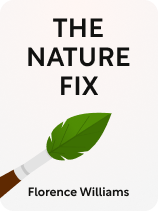

This article is an excerpt from the Shortform book guide to "The Nature Fix" by Florence Williams. Shortform has the world's best summaries and analyses of books you should be reading.
Like this article? Sign up for a free trial here.
What are the disadvantages of city life? Are city-dwellers really more stressed? How do cities affect sleep?
In the book The Nature Fix, Florence Williams explains that people who live in cities suffer from excess stress, poor sleep quality, a lack of sunlight, and less empathy. While cities do offer numerous advantages for employment, socialization, and entertainment, the benefits may not outweigh the downsides.
Here’s an in-depth look at the real cost of urban living.
The Cons of City-Living
While city living has its advantages, these come at a price. Williams writes that our brains still crave nature, so living in urban areas and having limited access to nature negatively affects our health and well-being. These are the major disadvantages of city life.
1. We’re Mentally Worn Down
First, living in the city means dealing with more noise, demands, and distractions, which make us more stressed and mentally exhausted.
Williams explains that city folk are constantly exposed to an urban soundtrack of police sirens, airplanes, and other man-made noises. These ever-present noises prevent us from fully relaxing; since our brains equate noise with threats, we’re perpetually in a state of alertness. Being on alert translates to an elevated heart rate and blood pressure—in other words, stress.
(Shortform note: Some people living in cities are subjected to more stress from exposure to noise than others. One study has found that in the US, noise pollution disproportionately affects residents of communities with a lower socioeconomic status and a bigger percentage of people of color. Regulations can help reduce noise levels—say from factories and airports—but the US government hasn’t done much in this regard. This is partly due to a chicken-and-egg scenario: Policymakers want more evidence before funneling more funding into noise research, but researchers need funding to conduct more research into the relationship between noise pollution and health.)
Exacerbating this stress is the multitude of things fighting for our attention, from a steady stream of emails to a limitless selection of TV shows. Over time, says Williams, the micro-stresses from our daily exposure to noise and stimuli accumulate into chronic stress (a prolonged state of stress), which leads to all sorts of physical ailments, including cardiovascular issues.
(Shortform note: In Why Zebras Don’t Get Ulcers, neurologist Robert Sapolsky details why humans are ill-adapted to dealing with chronic stress. He explains that while our ancestors had short-term stressors like famine and predators, we have long-term stressors like money and job worries. However, our stress response still hasn’t evolved to cope with these long-term stressors, leading to physical ailments. Aside from the ailments that Williams mentions, Sapolsky says that chronic stress also stunts growth, affects reproductive health, and speeds up aging.)
In addition to being stressed, we’re also mentally exhausted by the things that clamor for our attention. Williams explains that, according to Attention Restoration Theory (ART), we have two kinds of attention: The first is directed attention, which is the kind of focused, effortful concentration we use to meet the demands of city life—working on a project, navigating a busy street, responding to emails. The second is soft fascination, the effortless, involuntary attention we pay to things that are interesting or beautiful, like natural scenes such as the view from a mountaintop.
(Shortform note: Though Stephen and Rachel Kaplan introduced ART in 1989, the theory shares similarities with an age-old practice: Eastern meditation. In another study, Stephen Kaplan explores how meditation can help us recover from mental exhaustion and recharge our capacity for directed attention. A 2022 review supports Kaplan’s findings, concluding that mindfulness-based interventions—such as meditation and yoga—can help us recover from demanding mental activities. You can get the benefits of both being in nature and meditating through walking meditation outdoors: It employs the gentle engagement of soft fascination while also incorporating mindfulness to further help restore your capacity for directed attention.)
Because we live away from nature in cities, we use too much of our directed attention, and we don’t get many chances to engage in soft fascination. Williams argues that this leads to mental fatigue, making it harder to concentrate, solve problems, and control impulses, and possibly results in attention-related issues like ADHD and burnout. (Shortform note: Given the benefits of nature, some companies are incorporating biophilic design into their offices, integrating natural elements like plants and water as well as materials and forms that evoke nature. Biophilic design in the workplace has been shown to improve productivity and mood, increase self-esteem, and encourage relaxation.)
2. We’re Getting Poor-Quality Sleep
Aside from stressing us out in our waking hours, man-made noises also affect the quality of our sleep, explains Williams. Even as we sleep, we’re subconsciously attuned to noise—a nifty feature when our ancestors had to be able to detect threats while asleep (say, the sound of an approaching predator); not so nifty now that we don’t have the same threats our ancestors faced. This means we’re not getting enough restorative rest.
(Shortform note: We’re often told to get eight hours of sleep, but the quality of sleep is just as important as the quantity. How can you tell if those hours you’re getting are satisfactory? These are some of the characteristics of good-quality sleep, according to the US Sleep Foundation: 1) You fall asleep within half an hour of getting into bed, 2) you wake up only once or not at all in the middle of the night and fall back asleep soon after, and 3) you feel refreshed when you wake up. If your sleep quality needs improvement, these are other factors aside from noise that you may need to evaluate, writes Matthew Walker in Why We Sleep: caffeine and alcohol intake, room temperature, and light exposure—especially blue light from devices.)
3. We’re Not Getting Enough Sunlight
Another effect of spending more time indoors is that we’re missing out on the health benefits of sun exposure. Williams writes that the lack of sunlight means we’re not getting enough vitamin D; as a result, children in some parts of the UK have started developing rickets, a bone disease that results from vitamin D deficiency. (Shortform note: Though there has been a rise in cases of rickets, as Williams says, the numbers are still far fewer than those in the 1800s in London, when sunlight-blocking smog caused more than half of children to develop rickets. While the current level isn’t hugely alarming, doctors say we should stay vigilant, and they recommend increasing access to vitamin supplements for children.)
In addition to not getting enough vitamin D, we’re also suffering from myopia or nearsightedness. Williams explains that sunlight plays a role in shaping our eyes, so being indoors and away from the sun affects the development of our eyesight. Staring at a laptop or phone screen all day doesn’t help our vision either. (Shortform note: Lack of sunlight and increased screen time aren’t the only factors that lead to myopia; genetics may also come into play. One study found that among children of different ethnicities who were attending the same school in England—and thus had the same environment—myopia was more prevalent among British South Asian children than among white European and Black African Caribbean children.)
4. We’re Less Empathetic
Williams writes that on top of having negative effects on our mental and physical health, city living also affects us emotionally, making us less empathetic. Williams explains that being indoors means we miss out on the sense of wonder we get when we see nature’s beauty and grandeur, and this affects our feelings of connection with others. This is because research has found that this awe from seeing nature makes us more attuned to the larger world and the people around us.
(Shortform note: Beyond awe, nature can teach us a thing or two about empathy. In Braiding Sweetgrass, Robin Wall Kimmerer writes about the mutual care that plants exhibit and argues that observing plants can clue us in on how caring for each other can help individuals and communities thrive. She says that different species of plants work together in a way that benefits both of them, that plants demonstrate collective solidarity within a species to help everyone survive, and that plants and animals act in concert to restore an ecosystem after a disturbance such as a natural disaster.)

———End of Preview———
Like what you just read? Read the rest of the world's best book summary and analysis of Florence Williams's "The Nature Fix" at Shortform.
Here's what you'll find in our full The Nature Fix summary:
- Why humans have an innate affinity for nature
- How some countries are supporting their citizens’ health by giving them better access to nature
- Why the antidote to many of our physical and mental ailments is a good dose of the outdoors






